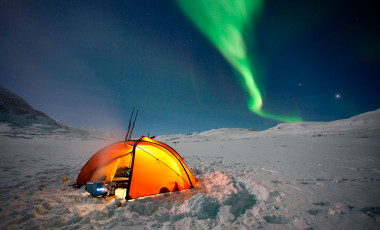Camping in winter requires a whole different set of gear and equipment to camping during the summer. And one of the most crucial things you’ll need is a winter tent that will stand up to the elements. Cold weather tents are designed with high winds, heavy rainfall, snowfall and condensation control in mind. So, although a three season backpacking tent may suffice in more moderate winter conditions, opting for a specific cold weather tent in more extreme temperatures and climates is essential.
As with all outdoor equipment, choosing a winter tent that is suitable to the conditions as well as the type of camping you’ll be doing, can be a bit of a minefield. There are loads of different types of cold weather tents out there that are all designed for very different winter camping scenarios.
Whether it is a night or two enduring the storms of high altitude mountaineering, or a week of wilderness living deep in the backcountry, this selection of some of the best cold weather tents in 2024 will have you covered. Take a quick look at your options and read on for more information on each type of winter tent.
- Types of cold weather tents
- What’s the difference between three and four season tents?
- Important features of winter tents
Summary of cold weather tents
Disclaimer: We use affiliate links and may receive a small commission on purchases.
| Product | Type of tent | Weight | Person capacity | Cost |
|---|---|---|---|---|
| MSR Access 2 | Winter expedition tent | 1.86kg (3.6 lbs) | 2 | $ |
| Slingfin WindSaber 2 | Winter expedition tent | 2.3kg (5 lbs) | 2 | $$ |
| The North Face VE 25 | Winter expedition tent | 4.7kg (10.3 lbs) | 3 | $$ |
| Hilleberg Nallo 3 GT | Winter expedition tent | 3.1kg (6.8 lbs) | 3 | $$$$ |
| NEMO Kunai 2P Tent | Winter expedition tent | 2.2 kg (4.8 lbs) | 2 | $$ |
| Samaya 2.0 Two Person Tent | Lightweight mountaineering tent | 1.3 kg (2.8 lbs) | 2 | $$$ |
| MSR Advance Pro | Lightweight mountaineering tent | 1.3kg (2.8 lbs) | 2 | $ |
| Rab Latok | Lightweight mountaineering tent | 1.4kg (3 lbs) | 2 | $$$ |
| REI Co-op Base Camp 6 Tent | Family/base camp tent | 9.3kg (20.6 lbs) | 6 | $ |
| Mountain Hardwear Trango 4 | Family/base camp tent | 5.8kg (12.8 lbs) | 4 | $$$$ |
| The North Face 2-meter Dome | Family/base camp tent | 23.13kg (51 lbs) | 10 | $$$$$$$$ |
| REI Arete ASL 2 | Budget winter tent | 2.8kg (6.3 lbs) | 2 | $$ |
| ALPS Mountaineering Tasmanian 2 | Budget winter tent | 3.5kg (7.7 lbs) | 2 | $$ |
| Geartop 4 Season | Budget winter tent | 2.6kg (5.75 lbs) | 2 | $ |
| Seek Outside 4 Person Tipi | Stove compatible tent | 1.96kg (4.3 lbs) | 2 | $$$ |
| Playdo 4-Season Bell Tent | Stove compatible tent | 37kg (81.5 lbs) | 6-8 | $$$ |
Types of cold weather tents
Choosing the right tent for your winter camping capers really comes down to what you are going to be using it for. And there are a number of different routes to go down, with each one covering a number of different camping scenarios. But to keep things simple, the main two types of winter tents are:
- Double-wall tents – have a rainfly (also known as an outer tent) that fends off the elements and covers the inner tent. The inner tent is the main sleeping area and is usually sealed off from the outside world thanks to a built-in groundsheet and zippered doors. The rainfly often extends over the inner tent to create vestibules or porches in which extra gear can be stored.
- Single-wall tents –as the name suggests, comprise a single layer of fabric protection between the sleeper and the outside world. This type of winter tent is essentially an inner tent but constructed from the tough, waterproof fabric of a rainfly. They are designed with low weight in mind to allow mountaineers to move quickly, whilst providing just enough protection from the elements to keep them alive and maybe even grab some much-needed zzzz’s whilst there in there! As such, most single-wall tents don’t score highly when it come to liveability and comfort. They are minimal and do their job just well enough. They also struggle to deal with condensation in the same way that double-wall tents do.
Unless you’re in the market for a winter tent whose primary function is to enable you to travel quickly through extreme mountain conditions, then you’ll most likely only be considering double-wall designs. There is, however, an exception to this, in the form of stove-compatible tents. You can read more about these in the cold weather tents with stoves section.
Cold weather tents by use
Now that we’ve established the difference between single- and double-wall tents, it’s time to look at the winter tent options based on the intended use.
Our list of winter camping tents include:
- Winter tents for alpine expeditions
- Lightweight mountaineering tents
- Winter tents for family camping and base camp
- Budget winter tents
- Cold weather tents with stoves
Winter tents for alpine expeditions
Winter expedition tents need to be light enough to carry for a day or two of trekking, but big enough to be comfortable for extended periods of mountain living. They are also suitable for those doing multi-day winter backpacking trips and wanting a little more comfort than super lightweight winter camping tents (below) provide.
Features to look for include:
Low weight
- Good liveable space
- Vestibules
- Internal storage features
- Easy and quick set up
- Vents

MSR Access 2
Weighing in at under 2 kg, the MSR Access 2 is one of the lightest four-season tents on our list. Like the Nemo Tenshi, this tent is very versatile. It has a double-wall design that holds up to moderate snow loads and handles condensation reasonably well. It’s suitable for use on winter expeditions under light snowfall, as well as summertime alpine expeditions, and damp shoulder seasons.
When it comes to liveability, this is a fairly spacious 2-person expedition tent. It’s easily wide enough to fit two sleeping mattresses plus small gear. Plus, there are two entrances with outer vestibules on either side of the tent where you can store boots, poles and wet gear.
Pros
- Versatile usage
- Quick to pitch
- Spacious
- Lightweight and compact pack size
- Mid-range price
Cons
- Outer vestibules have little weather protection (your kit may get wet)
Find the latest price on:
MSR | REI | Backcountry
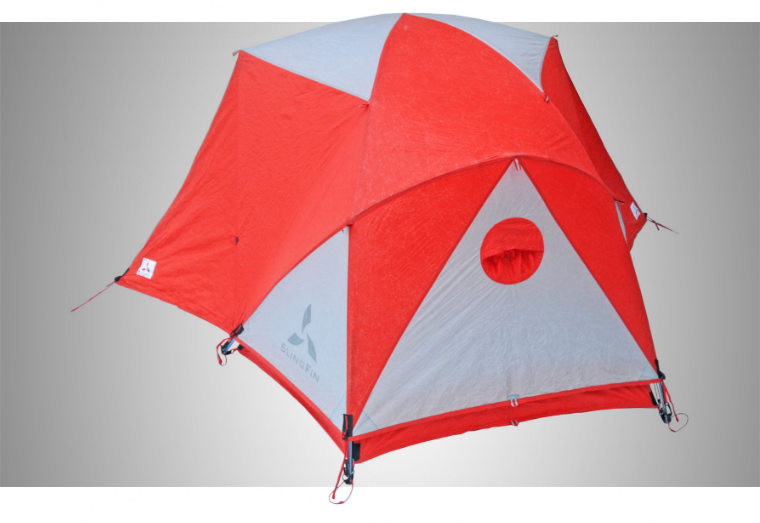
Slingfin WindSaber 2
The Slingfin WindSaber 2 is a functional 4-season tent comfortable for two people. It is equipped with two entrances and vestibules, which provides more space inside the tent to sleep as gear can be stored outside. What sets this tent apart from other dome-style 4-season tents is that it can be set up in multiple configurations, and the free-standing design makes it quick and easy to set up even in cold, windy conditions.
The tent’s interior is quite roomy and has optimal ventilation with drawstring openings at the foot and upper outer of the tent. Then, all you need to do is have a small opening at the top of the door to create enough airflow to reduce condensation to a minimum. Each vestibule also has a vent.
Pros
- Two entrances and vestibules
- Ideal ventilation for winter use
- High volume of guyline secure points
- Lots of places to hang gear with internal guylines
Cons
- Takes a few tries to figure out the multiple configurations
Find the latest price on:
Alpine Trek
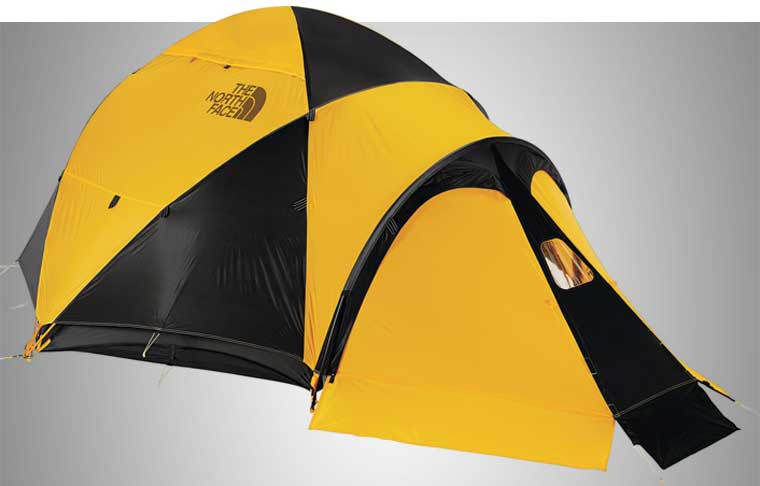
The North Face VE 25 Tent
Boasting 48 sq. ft. of floor space, the VE 25 Tent by The North Face is a superbly spacious three person cold weather tent. And although it is the heaviest winter expedition tent on our list, the extra weight is well worth it for mountaineers who value liveable comfort to ride out the storms in. The front vestibule has two doors with a poled middle section to provide stability. Plus, there is a rear entrance for extra convenience when living in close quarters with two other bodies!
Additionally, the configuration of four lightweight DAC poles provide a strength-to-weight ratio that is hard to beat. There are also multiple venting options to keep condensation levels under control, further adding to the relative luxury offered by this super sturdy tent for winter camping.
Pros
- Excellent ability to deal with high winds and snow
- Highly liveable
- Two entrances
Cons
- On the heavy side
Find the latest price at:
The North Face

Hilleberg Nallo 3 GT
If you want a high-quality wind-resistant tent that protects you from the elements while trekking, mountaineering, and high altitude expeditions, look no further than the Hilleburg Nallo 3 GT. It is a lightweight tunnel tent built for all four seasons of adventure. The tunnel tent design provides the optimal amount of space for the weight and size of the tent. It is listed as a three-person tent, and with the size of the vestibule, that would be feasible. Still, it will certainly be more comfortable with just two people, but there is still plenty of space if you have a child or dog traveling with you. The tunnel design also makes for a very functional ventilation system to prevent condensation by allowing airflow through the entire tent without compromising the level of insulation.
The outer tent or rainfly is compatible with the Nallo Mesh inner tent, which can be bought separately and used during warmer weather camping.
Pros
- Easy to set up
- Stormproof design
- Roomy interior width
- Large vestibule
Cons
- Not the most headroom (subject to the height of person using the tent)
Find the latest price at:
Alpine Trek | Hilleberg
Looking for something more lightweight?
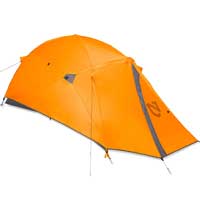
NEMO Kunai 2P Tent
- Sleeps 2
- 2.2 kg (4.8 lbs)
- Double wall
- 1 vestibule
- Snug for 2 people
Lightweight mountaineering tents
For alpine climbers and mountaineers, a lightweight tent is essential, and many opt for a single-wall design to keep the weight to a minimum. Ideally, it should be freestanding to enable it to be pitched in small and awkward spaces, with steep sides to shed snow effectively.
Features to look for include:
Very low weight
- Easy and quick set up
- Freestanding
- Small footprint
- Steep sides
- Vents
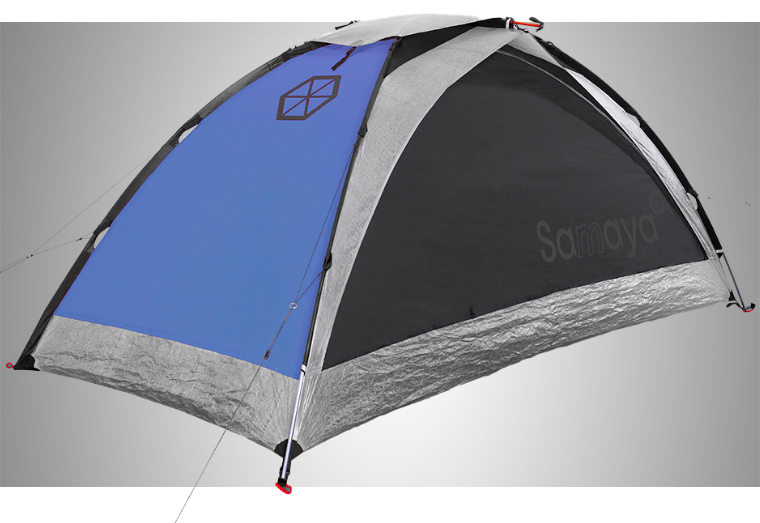
Samaya 2.0 Two Person Tent
The Sasmaya 2.0 is a dome-style 4-season tent that packs down small and is perfect for the lightweight adventurer (20 x 15 cm packed and weighs 1274 g). It saves a lot on weight by utilizing a single wall construction. To help with durability, the bottom of the tent has a tub-style design and is made from a tear-resistant Dyneema material. Plus, the outer wall has a three-layer construction and PU coating to ensure it is a windproof and waterproof design.
This is an excellent option if you’re looking for a 2-person tent for ultralight mountaineering missions that can be set up quickly in harsh conditions. Just keep in mind that although the single wall construction can reduce heat retention, it may not be as comfortable as other winter tent options. It will still provide the necessary level of protection from the elements.
Pros
- Ultralight design
- Repair kit included
- High quality, durable materials
Cons
- Single wall construction (a pro for some users)
Find the latest price on:
Alpine Trek
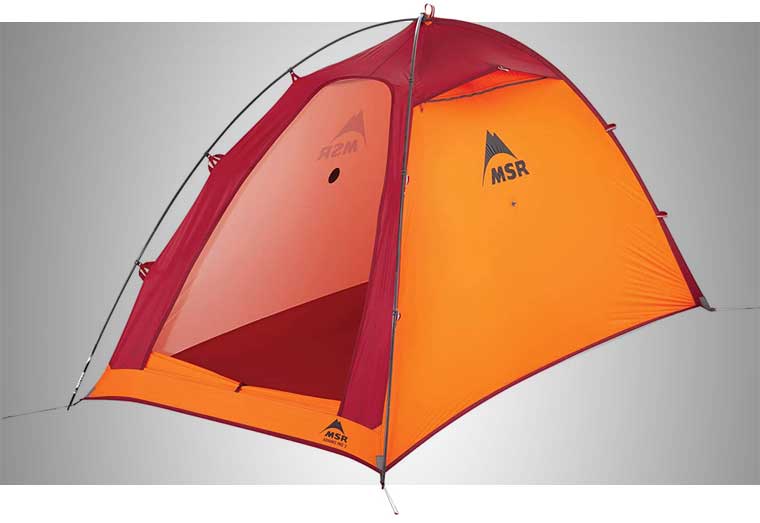
MSR Advance Pro
At a weight of just 1.3 kg, the MSR Advance Pro is one of the lightest mountaineering tents for cold weather on our list. This single-wall, dome-shaped tent with a small footprint is exactly what you need when weight, pack size, and weather protection are your top priorities. Ultralight Easton Syclone Poles are sturdy enough to withstand strong winds and heavy snow. And, reinforced guy rope attachments allow you to really anchor the tent on rough nights. Meanwhile, the tent itself is quick and easy to set up on your own.
Inside there are no bells or whistles. This winter tent is designed to protect you from the elements without weighing down your pack, so don’t expect much comfort. Also, due to the lack of ventilation (just one small vent), it doesn’t perform very well at lower elevations.
Pros
- Lightweight
- Small footprint
- Very strong
- Can be pitched solo
Cons
- Not very versatile
- Uncomfortable for taller people
Find the latest price on:
MSR | Amazon | Backcountry
Looking for another great lightweight single wall winter tent option?
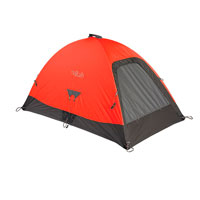
Rab Latok
- 2.1kg (4.64lbs)
- Sleeps 2-3
- Single wall
- No vestibule
Winter camping tents for family camping and base camp
The weight of your tent is not so much of an issue when it comes to car camping, and although you don’t want to be hauling a marquee out of your car, you can afford to prioritise a bit of luxury. Smart tent design becomes even more essential when you are dealing with larger tents, as they are much more easily affected by high winds.
Features to look for include:
Strong pole construction and design
- Good liveable space
- Vestibules
- Internal storage features
- Vents
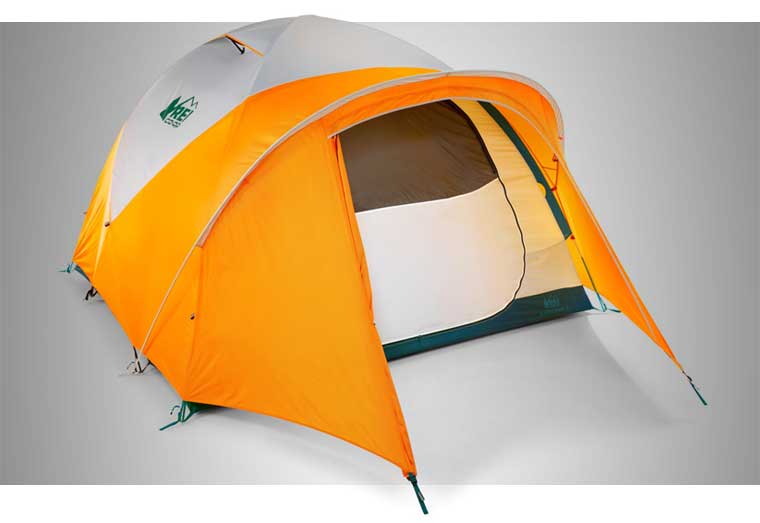
REI Co-op Base Camp 6 Tent
Large enough for all the family or a group of friends, the REI Co-op Base Camp 6 Tent is a 6-person tent with a strong geodesic-dome structure. With a generous head height of 74 inches, this is one of the few winter base camp tents that you can stand up inside. For easy entrance and exit, there are two wide roll-away entrance doors on either side – every camper can get in and out without waking anyone up! Two zippered side vents, roof vents, and mesh on the upper section of each door help to minimise condensation when camping in warmer seasons. Inside there are large mesh wall pockets for storing gear. There are also two outer vestibules, one staked and one pole-supported for your shoes and wet gear. Although it’s not the best tent for winter camping in heavy snow or extreme winds, the REI Co-op Base Camp 6 Tent is a spacious tent that’s tough enough for all four seasons in moderate conditions.
Pros
- Spacious interior
- Multiple internal storage pockets
- Easy setup
Cons
- Heavy
- Not the best for extreme winter weather
- Minimal ventilation in the flysheet
Find the latest price at:
REI

Mountain Hardwear Trango 4 Tent
With a generous inside space, a small outer vestibule and large dry-entry vestibule, the Mountain Hardwear Trango 4 Tent is a popular choice for extended trips in cold conditions, family camping, and base camps. The Trango 4 features a classic 4-pole geodesic design with DAC Featherlite aluminium poles. It’s extremely stable in harsh winter weather and is one of the best cold weather family tents for expeditions.
Inside there’s enough space for four people to sleep, head to toe, and just enough headroom for you to sit up inside. Mesh pockets help you keep your gear organised and off of the tent floor.
One disadvantage is that the Trango 4 is inner-pitch first. You’ll need to pitch fast if you arrive at your camping spot in rain or snow. However, the coded colour system does make it quick to pitch. It’s also freestanding, and you have the option of pitching it without the flysheet at lower elevations or in warmer seasons.
Pros
- Spacious interior
- Two vestibules
- Extremely strong
Cons
- Inner pitch first
- On the heavy side
Find the latest price at:
REI | Backcountry | Mountain Hardwear
Need something even bigger?
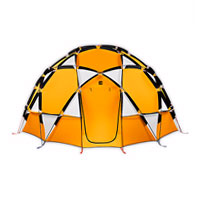
The North Face 2-meter Dome
- Sleeps 8
- 23.13kg (816oz)
- Double wall
- 3 doors
Budget winter tents
Most four season two person mountaineering and winter backpacking tents are around $600-$700 with some well over $800. And unless you plan on embarking upon regular winter expeditions and camping trips, many of those tents will be overkill for what you need. Thankfully, there are some really excellent quality four season winter tents that won’t break the bank but will still perform in the way that they should.
Features to look for include:
Strong pole construction and design
- Heavier materials usually make things cheaper
- Good liveable space
- Vestibules
- Lots of guy out options to help stabilise
- Vents
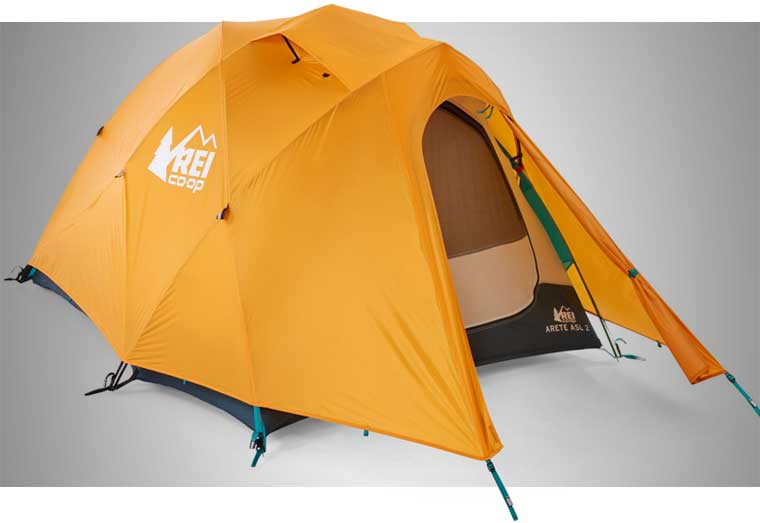
REI Co-op Arete ASL 2 Tent
Eco conscious: Contains materials that meet the Bluesign criteria
This updated version of the Arete may struggle to compete with its higher end counterparts when it comes durability and strength, but it still offers superb protection when under attack from snow and wind. Its has a siliconised 30D nylon fly which is a little thinner than many of the other options on our list, however, the improved fourDAC Featherlite Combi poles ensure high levels of structural stability to make up for it.
At only 2.8kg (6.3 lbs), the Arete is much lighter than The North Face VE 25 and only marginally heavier than the Eldorado. And impressively, that includes a 8.7 sq ft vestibule with improved internal living space. Along with two ceiling vents, the double wall tent has air flow well under control. And to top it off, this excellent value tent for cold weather tent camping also has multiple storage options including corner pockets, hooks and roof pockets.
Pros
- Highly liveable
- Decently strong in the wind and snow
- Is suitable for year-round camping
Cons
- Not as strong and durable as other higher end options
- Poles can be a little problematic to assemble
Find the latest price at:
REI
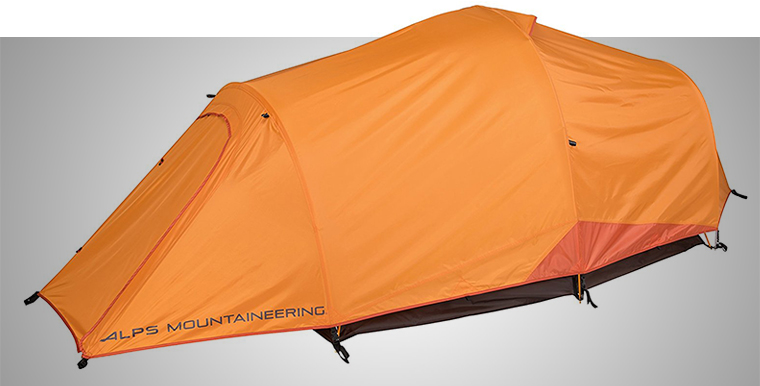
ALPS Mountaineering Tasmanian 2
With two doors and two vestibules, the ALPS Mountaineering Tasmanian 2 offers really excellent liveability for a two person winter tent and a 8ft2 more floor space than the Arete, making it a superb introductory winter camping tent with a very competitive price tag. It’s a little heavier than its competitors but shared between two people is no drama at all.
The unusual pole configuration provides a good amount of headroom in the centre of the tent, as well as really excellent stabilisation in high winds and steep sides. And with a tough 75D polyester fly the Tasmanian 2 just pips the Arete to the post when it comes to suitability as a winter tent.
Pros
- Stable in high winds
- Two vestibules
- Good liveable space
Cons
- Heavier than its competitors
Find the latest price on:
Amazon | Backcountry
Got a really tiny budget?
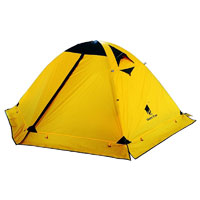
Geartop 4 season
- Sleeps 2
- 2.6kg (92oz)
- 2 vestibule
- Double wall
Cold weather tents with stoves
Choosing a ‘hot tent’ that is compatible with a stove, opens up a whole different kind of cold weather tent camping. It is suitable either for car campers, or for those hauling their gear into the wilderness on sleds. It is also not out of the questions for backpackers, as there are some very lightweight tents available if you also have a lightweight stove.
It’s super important to know what you’re doing before you go lighting up underneath flammable nylon. But when done properly, hot tent camping provides a rustic yet highly comfortable way to enjoy getting out into the wild right through the snowy season.
Features to look for include:
Stove port
- High ceilings
- Good liveable space
- Vents
- Strong fabrics and design
- Usually single-wall design

Seek Outside 4 Person Tipi
At only 1.96kg (69oz) this single wall tent is impressively light, even compared with 2 person three season tents. It may not look as stable as modern mountaineering and winter backpacking tent designs, but this Seek Outside Tipi will deal with high winds without a problem, if put up correctly. Adding a tent footprint (not included) will add a little extra weight, but the ability to set up the stove inside the tent and comfortably sleep two people (four without the stove), makes this a really appealing option as a base camp tent in the backcountry.
The nylon 30D fly, although relatively thin, is impregnated with Ultralight silicone and has a waterproof rating of 3000mm. Whilst its single carbon pole seems somewhat spartan on the stability front, the tent shape and guy outs provide enough toughness to weather the storm with confidence.
The tent also provides a whopping 115 sq ft of floor space and 6’10” of headroom at the tallest point, and of course features a stove port and vents to prevent condensation build up.
Pros
- Incredibly lightweight
- Good head room
- Accommodates a stove
Cons
- Only sleeps 2
- Doesn’t come with groundsheet
Find the latest price on:
Seek Outside
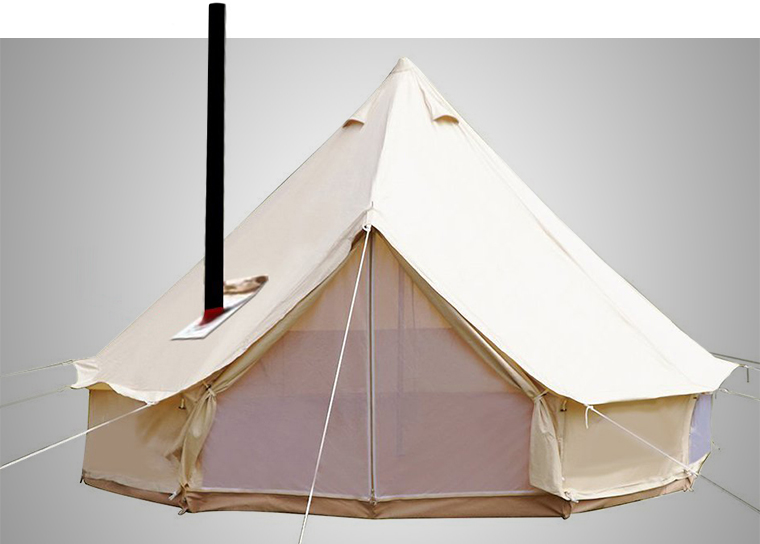
Playdo 4-Season Bell Tent
At 37kg (81.5lb), the Playdo 4-Season Bell Tent may be almost as heavy as all the above winter tents put together, but it offers a highly luxurious option for those determined to get out camping, whatever the weather! The thick cotton canvas is waterproof treated and connected to the PVC floor with taped seams for a completely draft-free, drip-free camping experience. At 5m wide and 3m tall, this is the largest winter tent in our review. And, like the Seek Outside Tipi, its height doesn’t equate to instability in bad weather – quite the opposite in fact. When put up well, bell tents are exceptionally robust in bad weather and their steep sides deal with excess snowfall well.
Bell tents offer a really great winter camping tent alternative for families, groups, glampers, car campers and hunters. And with a 5 inch port to vent your wood stove out of, and enough space to sleep up to 8 people, you’ll be glad for the mesh vents in the roof and tent sides!
Find the latest price on:
Amazon
Pros
- Super spacious and luxurious
- Stable in bad weather
- Has stove port
Cons
- Very heavy
- Only suited to car campers
Need a stove to keep the temperature up?

TMS Portable Camping Wood Stove
- 13.3kg (470oz)
- Interlocking sections to extend the flue pipe
- Removeable legs
- Easy to carry
What to look for in a great winter tent
Many of the cold weather tents for winter camping in this article look pretty much the same as tents you may already own, or ones you see all the time during the summer. But there are some key differences that make them that much more suited to cold weather tent camping than their fair weather cousins.
What’s the difference between three and four season tents?
Before we go any further, let’s talk about three and four season tents. After all, you may already have a great three season tent sitting at home that will cope perfectly well in less severe winter conditions. Here’s the difference:
Three season tents
Three season tents are designed for camping in spring, summer and fall, and are usually lighter in weight than four season tents. Although many of the best three season tents will hold up perfectly well in high winds and bad weather, their durability and strength will struggle to compete with cold weather tents, especially in snowy conditions. Additionally, even if it’s very cold but very little chance of snow and gale-force winds, the fabrics of three season tents may not be adequate enough to keep their inhabitants cosy. Most three season tents have inner tents that feature large mesh panels, designed to keep air flowing in and out and to be as lightweight as possible. In very cold conditions, this mesh will allow cold air straight into your sleeping space and prevent your own body heat from warming the air inside the inner tent.
That said, in less cold or extreme winter conditions, a high quality three season tent should cope perfectly well. Check out your options for the best three season backpacking tents.
Four season tents
Also known as cold weather tents, or winter tents, four season tents are designed to withstand high winds and heavy snowfall in cold winter conditions. Compared with three season tents, a good four season tent will:
- Usually be heavier
- Have steep sided walls to help prevent snow from settling
- Have stronger poles – usually aluminium
- Usually have more poles and more pole crossings
- Be made from tougher and more durable fabrics
- Usually cost more
Although designed with winter camping in mind, good four season tents should also be versatile enough to perform well during the spring and fall and not just in the snow. You could also get away with camping in a winter tent during the summer. However, the thicker fabrics, limited ventilation and minimal mesh panels would make for a fairly hot and sticky experience.
Important features of winter camping tents
Any great tent should be well made and fit for purpose. But there are also a load of other things to consider when investing in a cold weather tent.
Livability
Generally speaking, winter tents need to be a little more liveable than three season tents. If a storm hits, then spending a couple of days at a time stuck in your tent can become unfun very quickly. Unless, of course, you have a great book, some entertaining card games and an awesome cold weather tent. In which case, you should expect said tent to have the following:
A vestibule
A vestibule (also known as a porch) is a section of tent that is outside the inner sleeping area but still covered and protected by the rainfly. It provides extra space to store your outerwear (boots and jackets etc), and space where you can change into and out of your boots without bringing them into the main tent. The less damp stuff you bring into the main part of the tent the better. This prevents condensation buildup and internal frosting. Vestibules provide space to cook in, too.
Good ventilation
Having good ventilation is essential to keep on top of condensation and internal frosting, which occurs as the internal tent temperature rises and the outside temperature drops. Double-wall tents generally deal with condensation much better than single-wall tents as they designed to have better air circulation. Additionally, vents on the rainfly of double-wall tents help air flow in without risking opening up the tent to rain and snow too.
Space
As with any tent, the more space there is, the more comfortable you will be. However, there is a limit! Too much space in your sleeping compartment will make it more difficult to warm up the air with your body heat. On the other hand, there needs to be enough room to comfortably carry out the tasks that you need to carry out, especially if you are spending more hours in your tent than you might have planned. Enough headspace to sit up and get changed etc and enough floor space to lay your sleeping pads down should be the minimum.
Storage
Even the most lightweight tents will have some internal storage options which should include pockets, hooks, loops and even a gear loft. Some tents come with minimal storage options but have attachment points should you want to buy add-ins like gear lofts. The number and design of the pockets and hooks comes down to personal preference. However, any means to stay organised when camping in the cold should be adopted. You don’t want to be spending time searching for items like gloves and hats that you really should be wearing to stay warm.
Two entrances, if possible
If you are sharing a two person tent, then having a second entrance makes things so much easier. Constantly having your buddy climb over you and all your stuff to get out of the tent can soon become tiresome, for both of you. It is a less important feature for larger tents, but will for sure make things more convenient. That said, there will be times when you won’t be able to open one of the entrances due to the wind direction. This makes the entrance redundant, as well as adding a potential point of weakness against the elements.
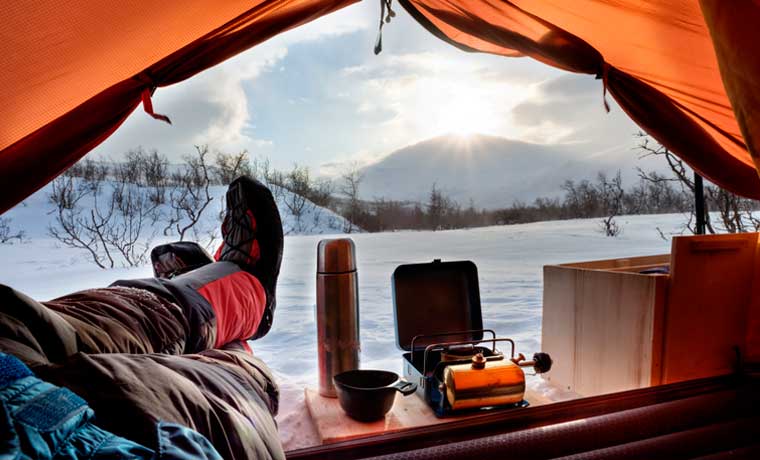
Strength and weather resistance
The most important features of cold weather tents are their ability to endure strong winds and deal with heavy snowfall effectively. Primarily, this comes down to tent design. But using the right materials for the job also contribute to the robustness of winter tents and their ability to stand up to bad weather time and time again.
Tent poles
For maximal stability, the more poles the better (in general). And things get even more stable if there are multiple poles crossing each other. Most winter tents have poles constructed of aluminium to balance weight and strength. The poles also should be thicker with stronger connection points than their three season counterparts to help prevent breakages due to extreme cold temperatures, as well as wind.
Some high end four season tents have carbon fibre poles for superior weight to strength ratio. However, this will increase the overall cost of the tent.
Tent fabric
The fabric of four season tents should be stronger than that of three season tents. The thickness of fabric is measured in Denier (D) with the higher number denier being thicker and usually stronger. And the thread count (T) is the number of threads used in a square inch. Again, the higher the thread count, the stronger the fabric is.
However, there are also different types of fabric construction that don’t need such a high denier or thread count rating to provide the same degree of strength. An example of this is Ripstop fabric where a stronger thread is incorporated into the weave at intervals. This construction helps to stop tears from spreading, should they occur.
Tent fabric waterproofing
To get a good idea of how waterproof a tent is, the outer rainfly fabric should come with an Hydrostatic Head (HH) rating. This measures (in mm) the amount of water that the fabric can withstand when under the pressure of a column of water. The higher the HH rating, the more waterproof the fabric will be.
Additionally, all cold weather tent rainflies should have a DWR (durable water repellent) coating; either impregnated with silicone, coated with PU (polyurethane) and silicone, or coated with PTFE (a non-toxic waterproof membrane).
Read more about the above ratings in our outdoor jargon article!
Weight
Due to the strong materials used, winter tents usually weigh more than three season tents. When it comes to backpacking, mountaineering and alpine expeditions, keeping things as light as possible can often be higher up on the priority list than comfort and livability. This is especially important when everything being carried weighs more than during summer expeditions; more food, more fuel, thicker sleeping bag, more layers, warmer sleeping pad etc. However, for those setting up their winter camp straight from the car, the weight of your tent is less of an issue.
Ease of set up
How easy a tent is to set up is an easily overlooked feature of a winter tent and is actually really crucial. The chances of having to put your tent up in the middle of a wind, rain or snow storm are actually pretty high. So the last thing you need is a tent that take ages to set up or is super fiddly when wearing gloves.
Ideally, a good winter tent should be designed so that the rainfly gets set up before the inner tent. This creates a dry space to store you gear as soon as possible and also prevents the inner tent from becoming wet. Additionally, the attachment points for the guy lines, stake out points and the inner tent should be easy and straightforward to use. A well designed four season tent will have these features covered.
Versatility
Just because a four season tent is designed for winter conditions, doesn’t mean that it is totally inappropriate for use during the rest of the year. In the ideal world, one tent would be suited to all our camping needs. But as this is a pretty tall order, it makes sense to choose a tent that will also perform well enough for the majority of the year. Versatile tents tend to be the most liveable, with a double wall set up being preferable to a single wall tent.
Cost
High quality and durable materials come at a price, and as mentioned, cold weather tents are usually more expensive than other tents. But picture yourself waking up in the middle of a snow storm with half your tent collapsed onto your face, and it’s easy to appreciate the importance of paying for that quality.



